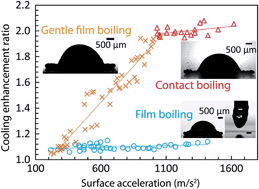Suppression of the Leidenfrost effect via low frequency vibrations
Abstract
The ability to suppress the Leidenfrost effect is of significant importance in applications that require rapid and efficient cooling of surfaces with temperature higher than the Leidenfrost point TSL. The Leidenfrost effect will result in substantial reduction in cooling efficiency and hence there have been a few different approaches to suppress the Leidenfrost effect. The majority of these approaches relies on fabricating micro/nano-structures on heated surfaces, others rely on inducing an electric field between the droplets and the heated surfaces. In this paper, we present an approach that induces low frequency vibrations (f ∼ 102 Hz) on a heated surface to suppress the effect. By mapping the different magnitudes of surface acceleration ![[greek xi with two dots above]](https://www.rsc.org/images/entities/i_char_e1ae.gif) sversus different initial surface temperatures Ts of the substrate, three regimes that represent three distinct impact dynamics are analyzed. Regime-I represents gentle film boiling (
sversus different initial surface temperatures Ts of the substrate, three regimes that represent three distinct impact dynamics are analyzed. Regime-I represents gentle film boiling (![[greek xi with two dots above]](https://www.rsc.org/images/entities/i_char_e1ae.gif) s ∼ 102 m s−2 and Ts ∼ TSL), which is associated with the formation of thin spreading lamella around the periphery of the impinged droplet; Regime-II (
s ∼ 102 m s−2 and Ts ∼ TSL), which is associated with the formation of thin spreading lamella around the periphery of the impinged droplet; Regime-II (![[greek xi with two dots above]](https://www.rsc.org/images/entities/i_char_e1ae.gif) s ∼ 102 m s−2 and Ts > TSL) represents film boiling, which is associated with the rebound of the impinged droplet due to the presence of a thick vapor layer; Regime-III (
s ∼ 102 m s−2 and Ts > TSL) represents film boiling, which is associated with the rebound of the impinged droplet due to the presence of a thick vapor layer; Regime-III (![[greek xi with two dots above]](https://www.rsc.org/images/entities/i_char_e1ae.gif) s ∼ 103 m s−2 and Ts ∼ TSL) represents contact boiling, which is associated with the ejection of tiny droplets due to the direct contact between the droplet and the heated surface. The estimated cooling enhancement for Regime-I is between 10% and 95%, Regime-II is between 5% and 15%, and Regime-III is between 95% and 105%. The improvement in cooling enhancement between Regime-I (strong Leidenfrost effect) and Regime-III (suppressed Leidenfrost effect) is more than 80%, demonstrating the effectiveness of using low frequency vibrations to suppress the Leidenfrost effect.
s ∼ 103 m s−2 and Ts ∼ TSL) represents contact boiling, which is associated with the ejection of tiny droplets due to the direct contact between the droplet and the heated surface. The estimated cooling enhancement for Regime-I is between 10% and 95%, Regime-II is between 5% and 15%, and Regime-III is between 95% and 105%. The improvement in cooling enhancement between Regime-I (strong Leidenfrost effect) and Regime-III (suppressed Leidenfrost effect) is more than 80%, demonstrating the effectiveness of using low frequency vibrations to suppress the Leidenfrost effect.


 Please wait while we load your content...
Please wait while we load your content...